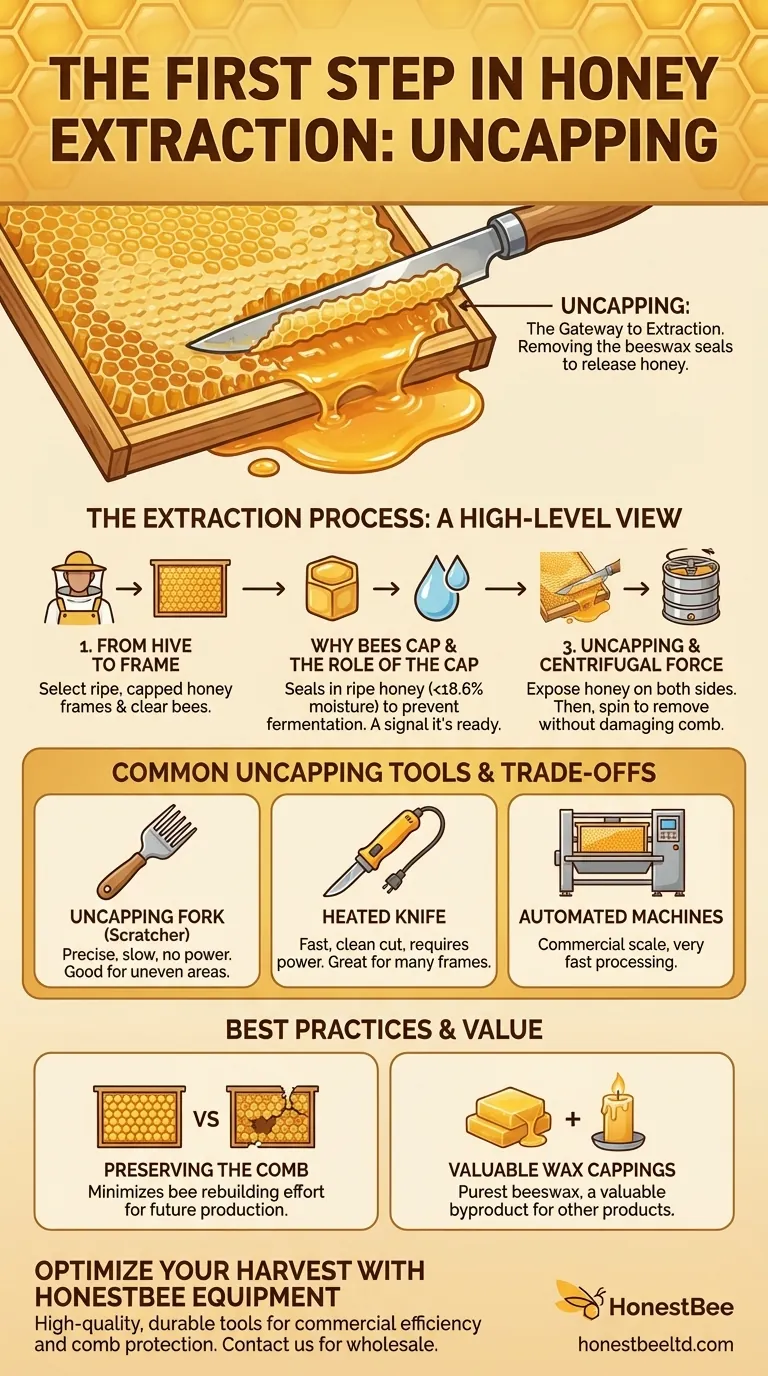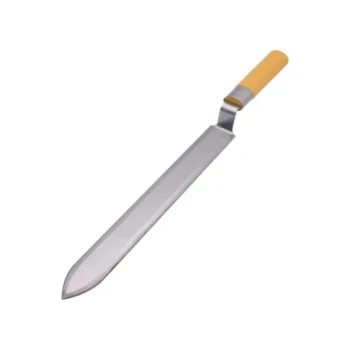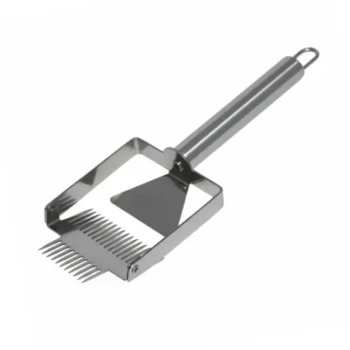The first step in the honey extraction process is uncapping. This is the critical task of removing the thin layer of beeswax that bees build to seal their honey-filled cells. Without first removing these protective wax caps, the honey cannot be removed from the comb.
The core principle of honey extraction is simple: you must first open the sealed honeycomb cells before you can get the honey out. This initial step, known as uncapping, is the gateway to the entire process, directly impacting both efficiency and the quality of the final product.

The Extraction Process: A High-Level View
To fully appreciate the role of uncapping, it's essential to understand where it fits within the larger workflow of harvesting honey. The process is a sequence of deliberate actions designed to move honey from the hive to the jar with minimal disruption.
### From Hive to Honeycomb
Before any extraction can begin, a beekeeper must first harvest the frames. This involves selecting frames from the hive that are full of ripe, capped honey and clearing the bees from them, often using a bee brush or a blower.
### Why Bees Cap Their Honey
Bees are meticulous. They cap honey cells with fresh beeswax only when the honey has reached the perfect moisture content (typically under 18.6%). This seal protects the honey from absorbing moisture and fermenting, preserving it indefinitely as their food source for winter.
### The Role of the Cap
The presence of a complete wax capping is the beekeeper's primary signal that the honey is "ripe" and ready for harvest. Attempting to extract uncapped, or "green," honey can lead to fermentation and spoilage.
Uncapping: The Gateway to Extraction
Once the frames are selected and free of bees, the uncapping process begins. The goal is to slice off just the top layer of wax, exposing the liquid honey within the hexagonal cells.
### What is Uncapping?
Uncapping is the physical act of removing the beeswax seals from the surface of the honeycomb. This must be done on both sides of the frame to allow the honey to flow out during the next stage.
### Common Uncapping Tools
Beekeepers use several tools for this task, depending on the scale of their operation.
- An uncapping fork or scratcher has sharp tines that pierce and lift the cappings. It is precise but can be slow.
- A heated knife (often electric) melts through the wax, providing a quick and clean cut that removes the cappings in a single sheet.
- Automated uncapping machines are used in large commercial operations to process hundreds of frames quickly.
### The Next Step: Centrifugal Force
Immediately after uncapping, the frames are placed inside a honey extractor. This device uses centrifugal force to spin the honey out of the open cells without destroying the delicate wax comb structure.
Understanding the Trade-offs
The method you choose for uncapping involves balancing speed, cost, and the preservation of your equipment. Each tool comes with its own set of considerations.
### Tool Selection Matters
A heated knife is significantly faster for processing many frames but requires a power source and careful handling to avoid burns. An uncapping fork is slower and more labor-intensive but offers greater control, requires no power, and is excellent for uneven or recessed areas of comb.
### Preserving the Comb
The primary goal is to remove only the wax caps while leaving the underlying honeycomb structure intact. Damaging the cells forces the bees to expend significant energy and resources to rebuild them, which can reduce their future honey production.
### Handling the Wax Cappings
The wax cappings removed during this process are a valuable byproduct. They are the purest beeswax in the hive and can be washed and rendered down for use in candles, balms, or other wax products.
Making the Right Choice for Your Goal
Your approach to uncapping should align with the scale of your operation and your long-term goals as a beekeeper.
- If your primary focus is a small-scale hobby: An uncapping fork is the most practical and affordable tool to start with.
- If your primary focus is efficiency and processing volume: Investing in an electric heated knife will dramatically speed up your workflow.
- If your primary focus is maximizing bee productivity: Master a gentle uncapping technique that minimizes comb damage, allowing bees to refill the cells with less repair work.
Ultimately, mastering the art of uncapping is the foundational skill for a successful and sustainable honey harvest.
Summary Table:
| Key Aspect | Description |
|---|---|
| First Step | Uncapping: Removing the beeswax seals from honeycomb cells. |
| Primary Goal | Expose honey for extraction while preserving the comb structure. |
| Common Tools | Uncapping Fork, Heated Knife, Automated Machines. |
| Impact | Directly affects extraction efficiency and final honey quality. |
Ready to Optimize Your Honey Harvest?
For commercial apiaries and beekeeping equipment distributors, the right tools make all the difference. HONESTBEE supplies high-quality, durable uncapping equipment—from heated knives to commercial-scale machinery—designed to maximize your efficiency and protect your valuable comb.
Contact HONESTBEE today to discuss wholesale pricing and find the perfect uncapping solution for your operation.
Visual Guide

Related Products
- Professional Compact Multi-Function Uncapping Knife for Beekeeping
- Professional Honey Uncapping Fork Tool with Customizable Tine Options
- Stainless Steel Pivoting Honey Uncapping Fork with Plastic Handle
- Stainless Steel Dual Blade Uncapping Plane
- Professional Stainless Steel Double-Sided Honey Uncapping Knife
People Also Ask
- What are hive tools used for in beekeeping? Essential Gear for Efficient Hive Management
- How is burr comb and propolis removed from a top bar hive? A Practical Guide for Hive Maintenance
- What is the recommended practice when using plain knives for uncapping? Master the Two-Knife Method for a Perfect Harvest
- Why is it recommended to have multiple hive tools? Boost Efficiency & Prevent Downtime
- How does a modified hive tool improve the uncapping of brood? For Precise Varroa Mite Diagnosis



















